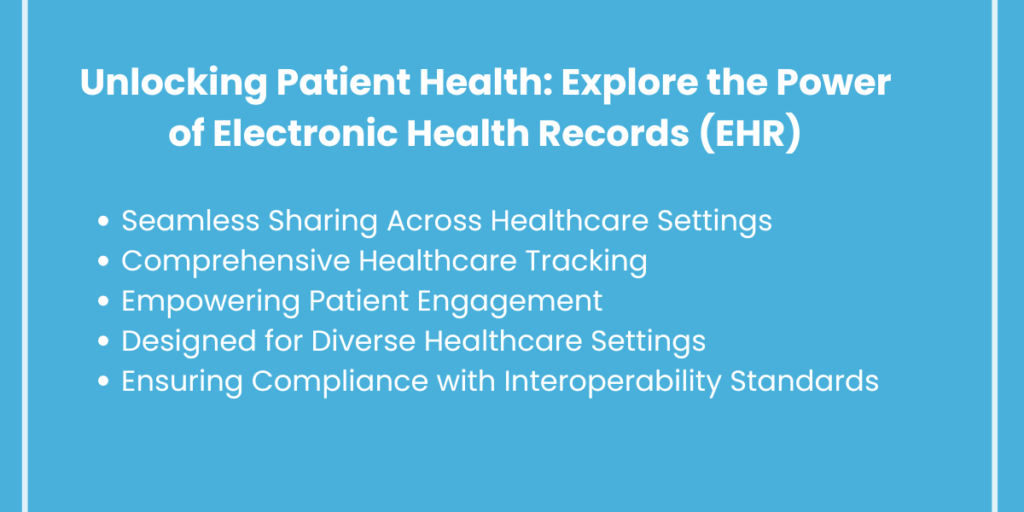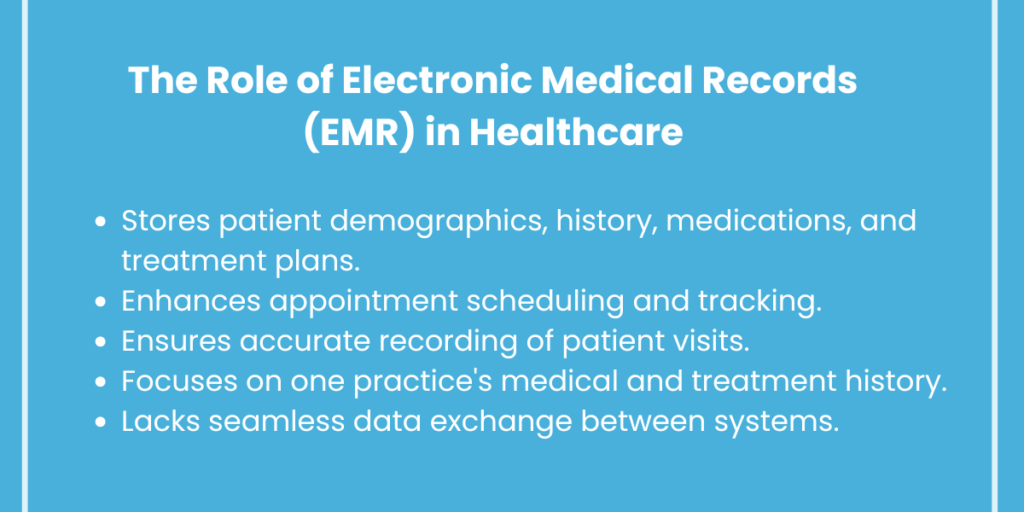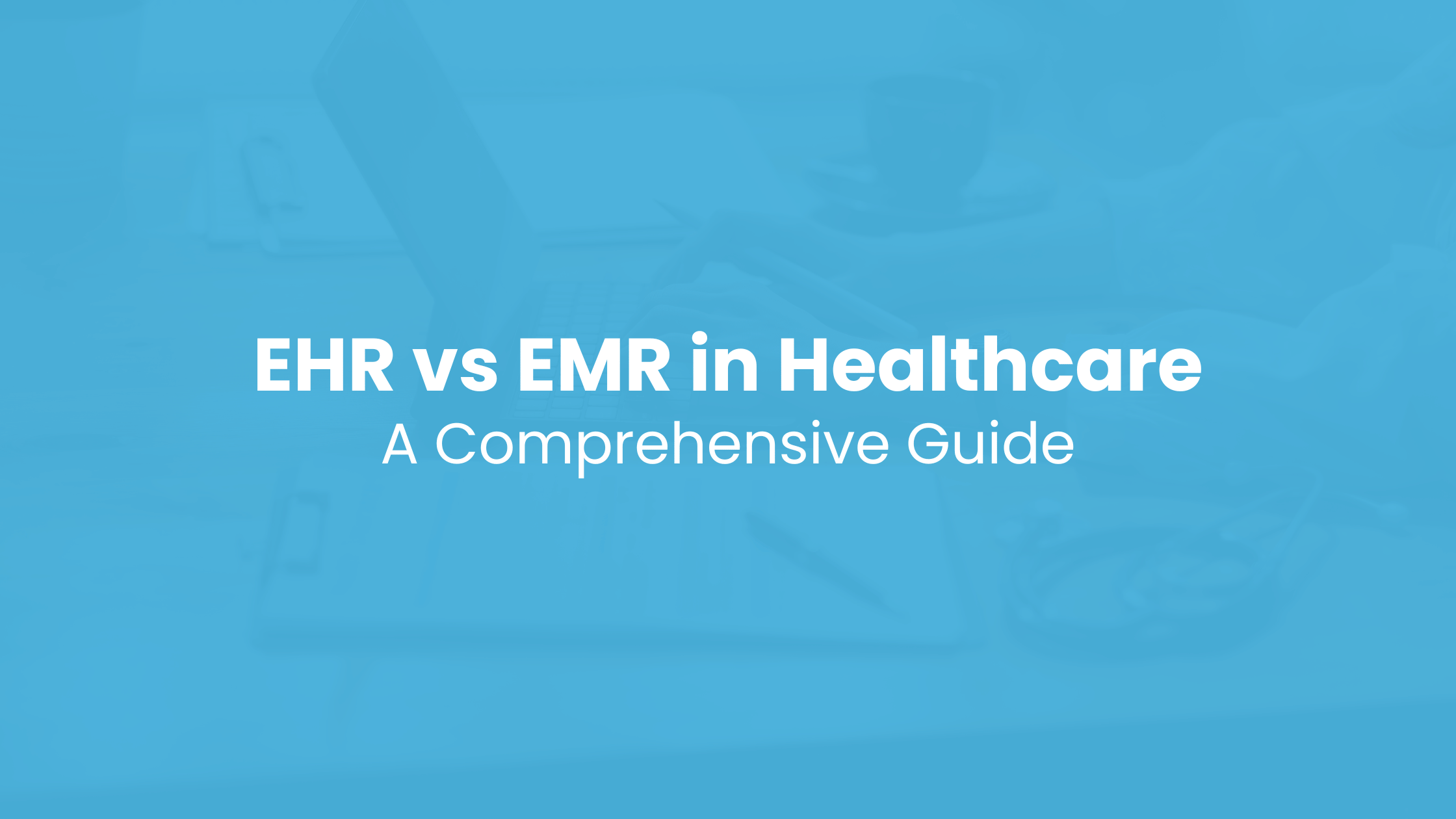EHR vs EMR in Healthcare
Electronic Medical Records (EMR) and Electronic Health Records (EHR) have revolutionized healthcare through the digitization of patient records, improving access to data, and enhancing the quality of healthcare. Knowing the specifics and uses is vital for healthcare professionals, particularly when it comes to medical billing.
Medical billing is heavily dependent on complete and accurate patient information. EMR and EHR software streamlines processes for billing, decreases mistakes, and assures prompt reimbursements. Utilizing these systems healthcare professionals can improve their billing efficiency as well as general financial stability.
What is Electronic Health Record?

The Electronic Health Record (EHR) is a full digital record of a patient’s general health. It’s intended to be shared among various healthcare settings, offering the complete picture of the patient’s medical history.
Key Features:
- Interoperability permits sharing of data between various health facilities and providers.
- Comprehensive Healthcare Tracking includes information from all healthcare providers who are involved in the care of a patient.
- Patient engagement typically includes patient portals that allow patients to gain access to their health information and to communicate with their doctors.
Key Differences:
- The system is designed for use in diverse healthcare settings, the app provides an extensive overview of the patient’s health history with data from a variety of healthcare providers.
- Interoperable, designed to allow seamless sharing of patient information across various healthcare providers and organizations.
- It is designed to comply with standards for interoperability, which facilitates the exchange and integration of information across different healthcare providers and systems.
- Features for patient engagement such as portals for patients, that allow patients to look up their health records, book appointments, and connect with their health providers.
- It provides a complete overview of a patient’s medical background, including details from different healthcare providers and encompassing a broad range of health-related information.
What is Electronic Medical Record?

Electronic Medical Records (EMR) and Electronic Health Records (EHR) have revolutionized healthcare through the digitization of patient records, improving access to data, and enhancing the quality of healthcare. Knowing the specifics and uses is vital for healthcare professionals, particularly when it comes to medical billing.
Medical billing is heavily dependent on complete and accurate patient information. EMR and EHR software streamlines processes for billing, decreases mistakes, and assures prompt reimbursements. Utilizing these systems healthcare professionals can improve their billing efficiency as well as general financial stability.
Key Features:
- Medical Data Storage Storage of the patient’s demographics, medical history medication, as well as treatment plans.
- Workflow Management improves workflow of a clinic by streamlining appointment scheduling and tracking.
- Enhances Documentation facilitates rapid and accurate recording of patient visits.
Key Differences:
- Most commonly used in the confines of a single practice in healthcare. It is focused on the health and medical history of patients in the practice.
- It contains particular medical and treatment history information from one particular practice, giving an encapsulated perspective of a patient’s health.
- Primarily used by healthcare professionals with limited features for interaction with patients. Patients generally do not have direct access to their health records.
- It generally lacking interoperability capabilities that make the exchange of data between EMR systems difficult, and frequently needs manual transfer of data
- It is only available to the healthcare provider who developed it. It isn’t easily accessible outside of the original procedure.
Evolution of Electronic Health Record (EHR)
The idea of EHRs came into existence as a solution to the weaknesses of EMRs and their lack of interoperability and sharing of data. The 1990s witnessed significant advances in the field of healthcare IT, which led to the creation of EHR systems that can connect data from several health care providers. It was the Health Information Technology for Economic and Clinical Health (HITECH) Act of 2009 further accelerated the adoption of EHRs, offering financial incentives for the effective utilization in these technologies.
Evolution of Electronic Medical Record (EMR)
EMRs have advanced significantly since their introduction around the year 1960. They were initially electronic models of traditional paper charts, used predominantly to store patient records within a single health practice. In the course of time, advances in technology and the requirements of regulatory agencies have led to the development of more advanced EMR systems that offer enhanced functionality that include improved storage of data retrieval, workflow, and management capabilities.
Applications of EHR and EMR in Medical Billing
EHRs help in the process of billing for medical services by providing a complete overview of the patient’s medical history. This makes sure that all relevant details are included in the claims, which reduces the chance of delays and denials. EHRs help to improve coordination between various healthcare providers, assuring that the information on billing is accurate and complete.
EMRs speed up the process of medical billing by ensuring timely and accurate recording of encounters with patients. This decreases the risk of billing errors and assures the processing of claims effectively. EMRs can also aid in the recording of diagnostic procedures and medical procedures increasing the precision of insurance claims made to insurance companies.
Latest Innovations in EHR and EMR
EHR system have experienced significant improvements, such as the incorporation machines learning and AI, enhanced data sharing capabilities, as well as enhanced features for patient engagement. These advances have enhanced the effectiveness of EHR systems and flexible, which has allowed for greater patient care and better coordination.
Recent advances in EMR technology include the creation of user-friendly interfaces that are more user-friendly enhanced capabilities for data analytics, and improved interoperability capabilities. These improvements have resulted in EMR devices more effective and effective, enhancing their functionality and usability.
Conclusion
EMR as well as EHR systems play an important function in modern healthcare, specifically in the field of medical billing. While EMRs are employed in one practice, EHRs offer broader data-sharing capabilities and favor a more complete view of the patient’s health. Both systems boost efficiency, accuracy, and patient care, however they also have their own challenges, such as technical complexity and security issues.
Healthcare providers must carefully consider their requirements and resources prior to making a decision among EMR as well as EHR systems. Implementing the desirable system could greatly increase the billing process as well as overall patient care, which can lead to improved outcomes and better financial health for the practice.

